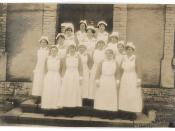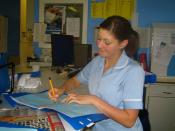The nurse in preoperative care is responsible for the patient's initial interview and examination. This nurse needs to elicit information that is important and will be used throughout the entire operative experience. According to Taylor (1997), the assessment "includes a nursing history and physical to establish baseline data, identify risk factors, and determine teaching and psychosocial needs of the client and the client's family."� The health history can be broken up into developmental considerations, medical history, medications, previous surgical experiences and perceptions and knowledge of the current surgery. Some lifestyle patterns that should also be included are nutrition, use of alcohol, drugs, and nicotine, activities of daily living, and occupation.
The patient must undergo certain screening tests that give the healthcare team data to provide a higher level of care. Taylor (1997) states, "usual screening tests include chest x-ray, electrocardiography, complete blood count, measurement of electrolyte levels, and urinalysis."� Physiologic values that are significant include an elevated white blood cell count that may indicate infection, a decreased hematocrit and/or hemoglobin, hypo/hyper kalemia, and an increased BUN or creatinine.
Postoperative teaching is also begun in the preoperative phase. The nurse must use their assessment to determine what are the teaching needs of the patient and their family. Once these have been identified, the nurse can explain to the patient what to expect and methods in which to deal with such stressors. By teaching before the surgery, it allows the patient time to practice different activities, and to figure out how they are going to rearrange their lifestyle. Some of the aspect the nurse teaches, according to Taylor (1997) include: surgical events and sensations, pain management, and physical activities, including deep breathing, coughing, incentive spirometry, leg exercises, and turning in bed. The patient and family must be instructed on what they...


